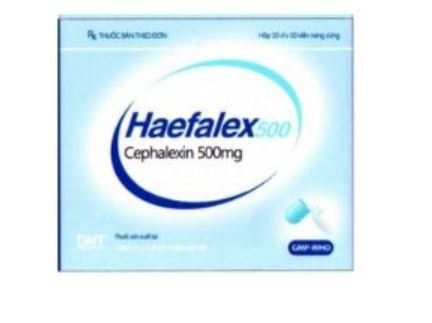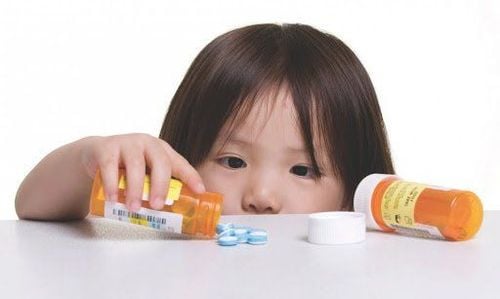This is an automatically translated article.
Cefatam 500 is a prescription drug with the active ingredient cephalexin with bactericidal activity on Gram (+) and Gram (-) strains of bacteria. Cefatam 500 is indicated in the treatment of infections caused by susceptible bacteria such as infections of the respiratory tract, urinary tract, obstetrics and gynecology, skin, soft tissue...
1. What is Cefatam 500?
Cefatam 500 is a prescription drug, made in the form of hard capsules, including some of the following active ingredients and excipients:
Active ingredients include: Cephalexin (Cephalexin monohydrate) - 500 mg; Excipients: Lactose monohydrate, colloidal silicon dioxide and magnesium stearate.
2. Indications of Cefatam 500mg
Cefatam 500 contains active ingredient Cephalexin is a Cephalosporin antibiotic, has bactericidal activity against Gram (+) and Gram (-) strains of bacteria, the drug is indicated for the treatment of the following infections caused by Sensitive bacteria:Respiratory tract infections: Acute and chronic bronchitis,...; Ear - nose - throat infections, otitis media, sinusitis, pharyngitis, tonsillitis, mastoiditis; Skin infections, soft tissue infections; Bone and joint infections; Urinary tract infections (including acute prostatitis); Dental infections; Obstetric and gynecological infections; Gonorrhea (where penicillin is not used). 3. Dosage of Cefatam 500mg Adults:
The usual dose is 1-4g, divided into 3-4 doses in 1 day. Most infections respond to Cefatam 500 mg every 8 hours; For strep throat, skin and soft tissue infections, and mild uncomplicated urinary tract infections, the usual dose is 250mg every 6 hours or 500mg every 12 hours; For infections with less susceptible organisms or more severe infections, a higher dose may be considered. If doses higher than 4 g/day are used, another parenteral cephalosporin with a dose appropriate for the patient may be considered; Elderly and patients with impaired renal function: For adults, reduce the dose to a maximum of 500mg/day if renal function is severely impaired (glomerular filtration rate <10ml/min). Children with a dose of 25-50mg/kg/day, divided into several doses. In most cases of bacterial infections, the recommended dose in children is as follows:
Children <5 years old: 125mg every 8 hours; Children > 5 years: 250mg every 8 hours; Doubling the dose may be considered in severe infections. Clinical studies show that the dose used to treat otitis media can be up to 75-100mg/kg/day, divided into 4 oral doses. Streptococcus beta-hemolytic streptococci should be treated for at least 10 days. 4. Side effects Call your doctor if you have the following side effects:
Severe stomach pain, watery or bloody diarrhea (even if it occurs several months after the last dose of treatment); unusual tiredness, feeling light-headed or short of breath; easy bruising, unusual bleeding, purple or red spots under the skin; Pale skin, cold hands and feet; Jaundice, dark urine; Fever, weakness, pain in the side or lower back, painful urination. Common side effects of Cefatam may include:
Diarrhea, nausea, vomiting, indigestion, stomach pain, itching or vaginal discharge. This is not a complete list of side effects and other possible side effects. If other reactions occur, contact your doctor for advice.
Get emergency medical help if you have signs of an allergic reaction to Cefatam such as hives, difficulty breathing, swelling in your face or throat; severe skin reactions such as fever, sore throat, burning eyes, skin pain, red or purple skin rash, blistering and peeling.
5. Contraindications to the use of Cefatam 500
Hypersensitivity to active ingredients Cephalexin and excipients; Cephalosporins should be used with caution in patients sensitive to penicillins, as there is some evidence of partial cross-allergenicity between penicillins and cephalosporins. The patient had a serious reaction (including anaphylaxis) to both drugs. Cefatam (active ingredient Cefalexin) is contraindicated in patients with acute porphyria.
6. Note before using Cefatam 500mg
Do not use Cefatam 500mg when allergic to cephalexin or other cephalosporins; To make sure it is safe to use Cefatam, tell your doctor if you have a history of allergies to any medications (especially penicillin), liver or kidney disease, intestinal problems, such as colitis; Cefatam is not expected to harm an unborn baby; Cefatam excretion in breast milk is increased up to 4 hours after a dose of 500 mg. Caution should be exercised when Cefatam 500 is administered to a nursing mother, because the neonate is at risk of Candida infection and CNS toxicity due to the immaturity of the blood-brain barrier; Tell your doctor if you are pregnant or breast-feeding. 7. Drug interactions Cephalosporins can increase the risk of nephrotoxicity when combined with drugs: Amphotericin, loop diuretics, Aminoglycosides, Capreomycin or Vancomycin.
As with other beta-lactam drugs, renal excretion of Cephalexin is inhibited by probenecid. Therefore, it causes a decrease in the excretion of cefalexin, leading to an increase in drug plasma concentrations.
8. Treatment of Overdose Symptoms of an oral overdose may include nausea, vomiting, epigastric pain, diarrhea, and hematuria.
In case of serious overdose, general recommendations include close clinical and laboratory monitoring of hematology, coagulation status, renal and hepatic function and until the patient is stable.
Please dial HOTLINE for more information or register for an appointment HERE. Download MyVinmec app to make appointments faster and to manage your bookings easily.













